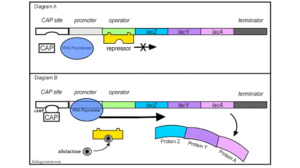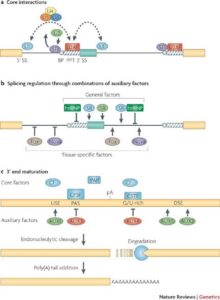Back to: MICROBIOLOGY 500 LEVEL
Welcome to class!
My ever-curious scientist, welcome back! You’re doing so well, and it’s clear you’re not here to joke—na real microbiologist you be! Today’s lesson is like understanding how your favourite music track goes from being written in the studio to being fine-tuned, edited, and finally released on your playlist. That’s exactly how cells manage gene expression—with serious attention to detail! Let’s understand how genes are turned on or off and how their messages are processed before being used.
Transcriptional And Post-Transcriptional Control
Just because a gene exists in your DNA doesn’t mean it will be used all the time. Your cells are very selective. For example, the cells in your eyes don’t need to make digestive enzymes, and the cells in your stomach don’t need to make melanin for your skin. So how do cells know which genes to use, when to use them, and how much to use? That’s where transcriptional and post-transcriptional control come in.
Transcriptional Control

This is the first level of gene regulation. It happens when the cell decides whether or not to transcribe a gene into RNA in the first place.
Think of this like turning on a generator only when there’s a blackout—you don’t just run it all the time. The cell only transcribes a gene when it’s needed.
Key players in transcriptional control include:
Promoters – These are specific DNA sequences where RNA polymerase binds to begin transcription.
Transcription factors – These are proteins that help control the activity of genes. Some increase transcription (activators), while others block it (repressors).
Enhancers and silencers – These are distant DNA elements that can boost or reduce the transcription of specific genes.
Example: When there’s a bacterial infection, immune cells in your body increase transcription of genes that produce antibodies. But once the infection is gone, they reduce that activity. Efficient, abi?
Post-Transcriptional Control
Now, imagine you’ve written a love letter (the RNA) but want to correct the grammar, remove some parts, and maybe seal it with a smiley sticker before sending it out. That’s what post-transcriptional control does—it manages the RNA after it has been made from DNA, but before it is translated into protein.
Key stages include:
RNA splicing – The RNA made from DNA includes unnecessary parts called introns. These are removed, and the useful parts (exons) are joined together.
5’ Capping and 3’ Poly-A tail – These modifications protect the RNA and help it be recognised by ribosomes.
RNA transport – The mRNA must be moved from the nucleus to the cytoplasm. If this doesn’t happen, no protein is made.
RNA stability and degradation – Some RNAs are made to last long, others break down quickly. This controls how much protein is produced.

Why This Control Matters
Without these controls, cells would waste energy making proteins they don’t need or making them at the wrong time. It’s like producing 1000 meat pies when only 100 are needed—you’ll just waste time, ingredients, and money. In the body, that kind of waste or mistake can lead to diseases, including cancer.
Summary
- Transcriptional control determines if a gene should be transcribed into RNA. It involves promoters, transcription factors, enhancers, and silencers.
- Post-transcriptional control regulates the RNA after it’s been made, through splicing, capping, tailing, transport, and degradation.
- These controls help the cell save energy, respond to its environment, and prevent errors.
Evaluation
- What is the role of transcription factors in gene expression?
- Explain one difference between transcriptional and post-transcriptional control.
- Why is RNA splicing important?
You’re doing excellently well! Just like a skilled engineer checks each stage of a machine’s operation, you’re now learning how the cell checks each stage of gene expression. Keep your brain active and your passion alive—Afrilearn is walking this journey with you. See you in the next lesson, champ!
